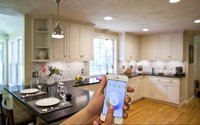 Consumers in the U.S. appear to be warming up
to the idea of smart lights in their homes.
Consumers in the U.S. appear to be warming up
to the idea of smart lights in their homes.
The majority (76%) of consumers now say that smart lights will ultimately replace regular lightbulbs, based on a new study.
There also is an
increase in general awareness of the idea of smart lights, with most (65%) consumers having heard of smart lights and more than 60% saying that smart lights fit their lifestyle.
The study, the
Osram Sylvania Socket Survey, was conducted by KRC Research for Sylvania and comprised a survey of 1,000 U.S. adults on their attitudes toward energy-efficient lighting.
The lighting study has
been conducted regularly since 2008, with the category of smart lighting added along the way.
Along with heightened awareness is increased adoption.
Compared to last year, 40% more
consumers own smart lighting, which now places smart lighting among the top three owned smart technologies by U.S. consumers. The other two are smart thermostats and connected house alarms, according
to the study.
Connected smart lighting systems can drive interesting new opportunities for brands, according to Aaron Ganick, who heads the Smart Home Americas division for LEDVANCE
(Sylvania).
“Company colors can be displayed using direct or indirect accent lighting, the age old ‘blue light special’ could be re-imagined, social gaming could be
integrated as part of an interactive search,” Ganick told the IoT Daily.
“Hunting for the latest Pokémon using your Pokémon Go app? Perhaps the lighting around you
can change colors before, during or after your battle,” he said.
While retailers are experimenting with using smart lights to communicate between devices, as reported earlier here (Philips Lighting and Disney Research), the ability to remotely control the lights can be used to
communicate with consumers in retail.
The principles remain the same with targeting consumers and connecting them with products based on location.
“Think about a T-Mobile story
painted pink, vs. an Abercrombie and Fitch dark but guided experience,” Ganick said. “Lighting can be used to emphasize a message, highlight a particular product (using a spotlight, etc.)
or simply to showcase one’s brand experience and style.”
“Now that lighting has become digital and controllable, we have the opportunity to change these messages on a
monthly, daily, or even hourly basis. All without needing to physically replace your lights, but with the simple touch of an app, or using an automated schedule.”